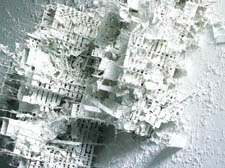|
|
 |
| |

Detail of Gerry Judah's 'White Country' |
Modern art of destruction
Gerry Judah’s 3-D paintings hit home a powerful message of war,
writes Dan Carrier
TAKING a sledge-hammer to a work of art that has taken you hundred’s of hours and buckets of perspiration may seem eccentric behaviour.
But for Gerry Judah, wrecking the intricate models of cities he has built is the final stage of creating hard-hitting 3-D paintings that consider the effect our inhumanity has on the cities we call home. “It deals with contemporary war zones,” says the Highgate-based artist. And to create them he builds scale model cityscapes, complete with such detailing as individual homes with all the utilities they would need – then he smashes them to pieces, as if they had been targeted by bombers.
It is not the first time urban warfare has inspired artists – Picasso’s Guernica is perhaps the best-known example. Like Picasso, who was moved to create this work after the Nazi bombing of the Basque town, Gerry acted to express his shock over the conflicts in the Middle East, Iraq and Afghanistan. He considers the way a city is organically developed to become a place with a sense of its own identity, and then becomes a tangled mess.
“I wanted to look at the devastation caused by modern conflict,” he says. “It is about how urban landscapes are destroyed, the impact of this and how it levels places.”
Gerry bases his models on a generic city – Beirut, Kabul, Baghdad – and the level of detail tells the story of his background: he is a renowned sculptor whose professional work has included building stage sets for Paul McCartney, Michael Jackson and Led Zeppelin as well as film work.
His work has won the praise of Middle East correspondent Robert Fisk who recalls the experience of being in Beirut after the Lebanese civil war had ended.
“For years after the Lebanese civil war ended, I would prowl the ruins of downtown Beirut... to find that the poor had gravitated into the collapsed buildings, into the wreckage of dentists’ shops and post offices and stores,” he writes as an introduction to the exhibition.
“These troglodytes, whole families of them, had fled from their own ruins in southern Lebanon – bombed by the Israelis – to seek sanctuary in bigger ruins. They were there with their children and their grandparents, with a litter of precious pots and bowls and gas fires and damp bedding, gaunt in the winter cold as the rain guttered down the walls, sweating through the humid summers until the bulldozers came to drive them out.”
He compares this to the ruins of Europe after the Second World War, but adds that Gerry’s paintings are strictly contemporary through their finer detailing.
“The wires and satellite dishes speak of the death of the modern as well as of the past,” he states. “They are the destruction of Jenin and Baghdad, of the Iran-Iraq war, of Belgrade, great apartment and office blocks and TV stations. They lack the rubble-ised chaos of car bombings for they have been computerised to death. This is the vision on the screens of the Cruise missile, the last green TV silhouette of ‘targeted ruins’ – for the bomb-aimers of our latest wars are always reporting that there is no longer a ‘target-rich environment’ because all the targets have already been destroyed.
“So they are bombing the ruins, turning the rubble, smashing up the last satellite dishes. What Judah’s work is saying is that these structures are now irredeemably gone, beyond repair, beyond re-creation.”
•
|

|
 |
| |
|
 |
|

